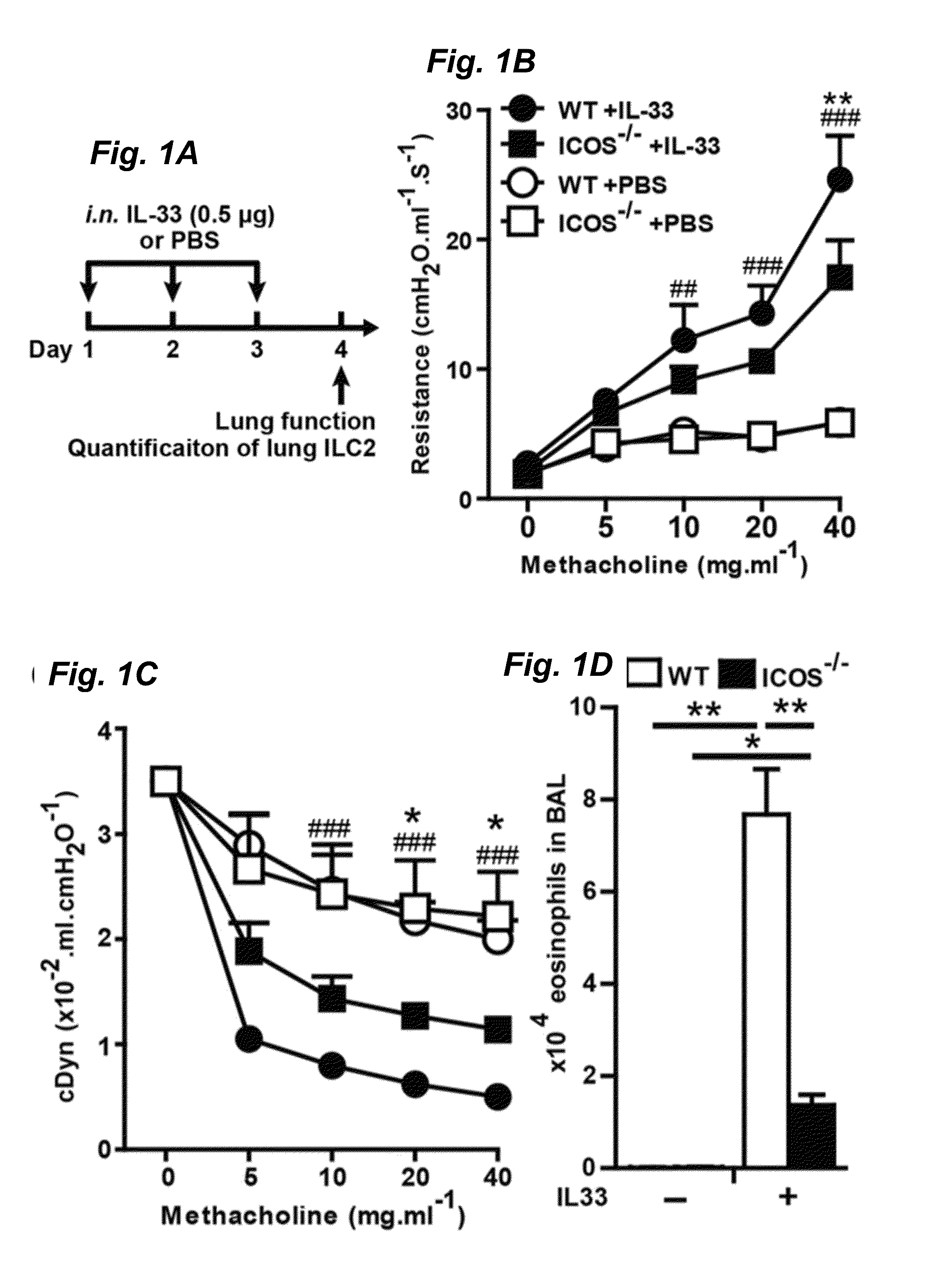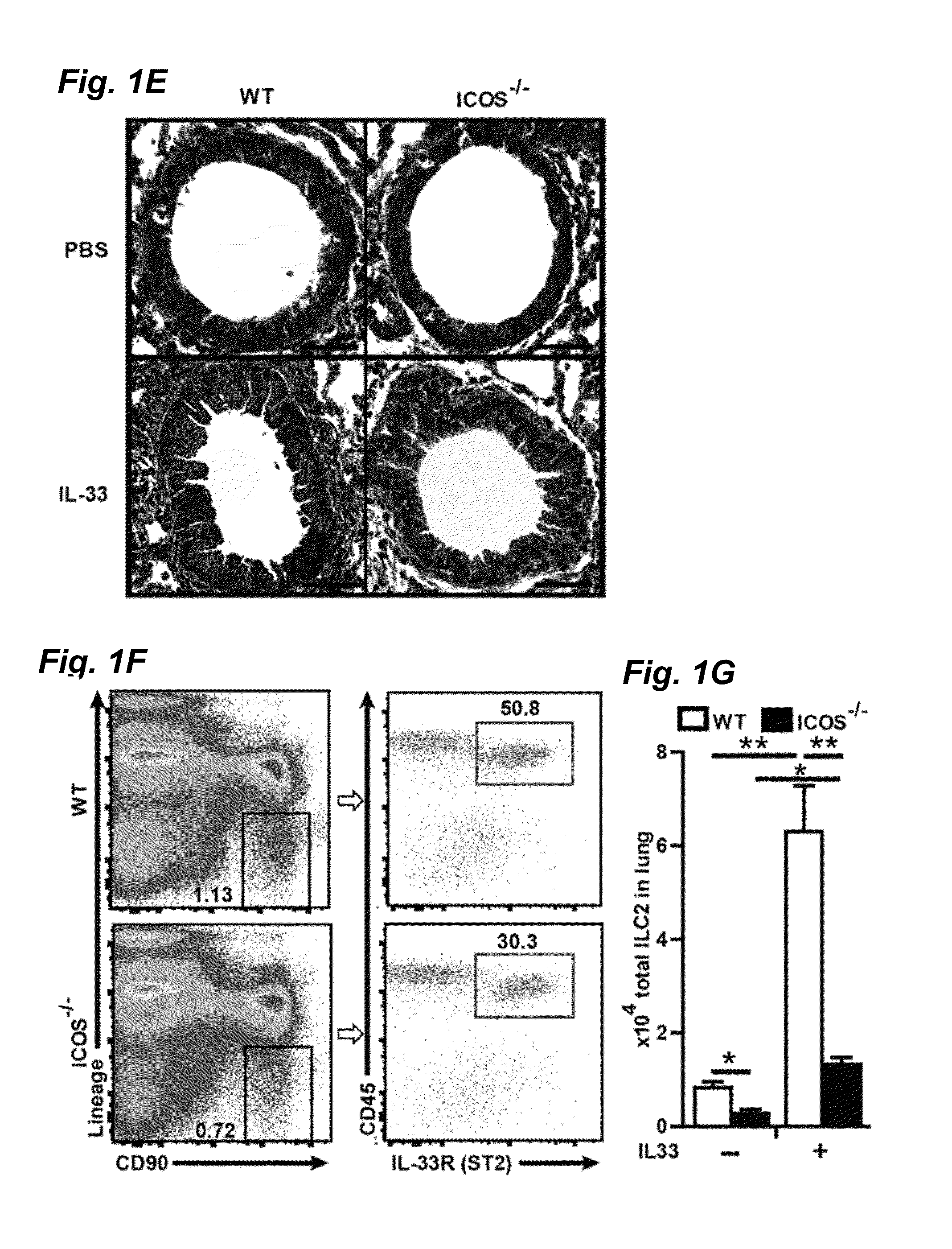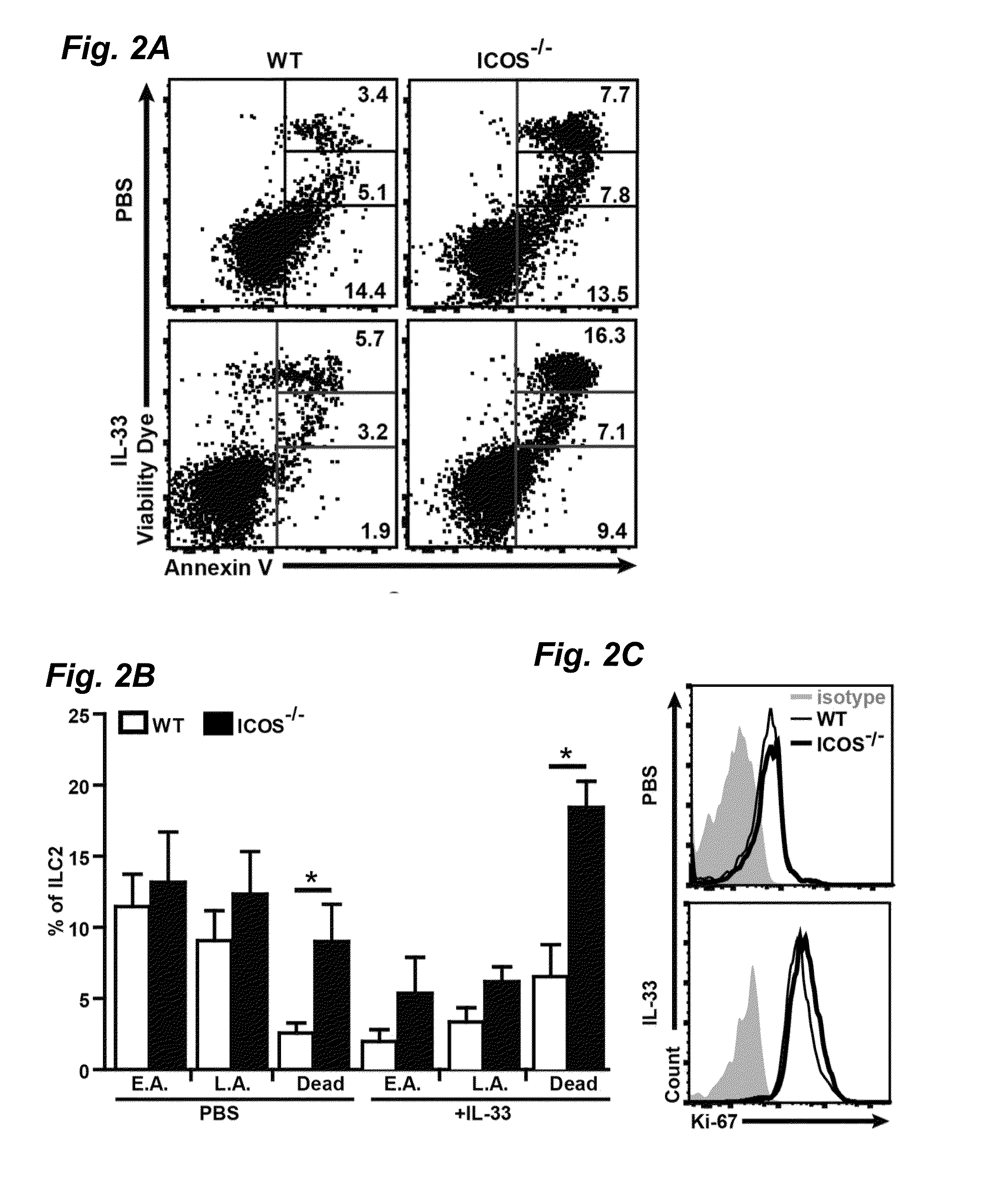Murine and human innate lymphoid cells and lung inflammation
a human innate lymphoid and murine technology, applied in the field of murine and human innate lymphoid cells and lung inflammation, can solve the problems of lack of rearranged antigen-specific receptors, and achieve the effect of modulating inflammation in the subject and reducing the phenotype of type 2 ilcs (ilc2) cells
- Summary
- Abstract
- Description
- Claims
- Application Information
AI Technical Summary
Benefits of technology
Problems solved by technology
Method used
Image
Examples
example 1
Mice and In Vivo Experiments
[0031]ICOS deficient mice were obtained and backcrossed 11 times to BALB / cByJ as previously described. RAG2 deficient (C.B6(Cg)-Rag2tm1.1Cgn / J), RAG2 GC deficient (C;129S4-Rag2tm1.1FlvIl2rgtm1.1Flv / J) breeder pairs and BALB / cBYJ experimental mice were purchased from the Jackson Laboratory (Bar Harbor, Me.). RAG2 deficient, RAG2 GC deficient and ICOS deficient mice were bred in the Inventors' animal facility at USC. 5-8 weeks age-matched female mice were used in the studies. For in vivo stimulation studies described in FIGS. 1, 4 and 5, carrier free recombinant mouse IL-33 (Biolegend, San Diego, Calif., 0.5 μs / mouse in 50 μl) or PBS (50 μl) was administered intranasally to mice on three consecutive days. One day after the last intranasal stimulation lung function was measured, mice were euthanized and samples were taken. For Alternaria experiments described in FIG. 6, Alternaria alternata (Greerlabs, Lenoir, N.C., 100 μs / mouse in 50 μl) or PBS (50 μl) was ...
example 2
Flow Cytometry Antibodies and Reagents
[0032]Biotinylated anti-mouse lineage (CD3e, CD45R, Gr-1, CD11c, CD11b, Ter119, NK1.1, TCR-γδ and FCεRI), Streptavidin-FITC, Streptavidin-BV510, BV421 anti-mouse CD25, BV510 anti-mouse CD90.2, PE Annexin V, Annexin V binding buffer were purchased from Biolegend (San Diego, Calif.). APC anti-mouse CD127, PerCP-eFluor® 710 anti-Mouse ST2 (IL-33R), Streptavidin APC-eFluor® 780, PE anti-mouse ICOS (CD275), PE / Cy7 anti-mouse CD117 (c-kit), FITC anti-mouse Sca-1, PE / Cy7 anti-mouse CD45, FITC anti-mouse CD45, PE anti-mouse IL-5, PE / Cy7 anti-mouse IL-13, PE / Cy7 anti-mouse IL-4, APC anti-mouse IL-13, eFluor® 660 anti-mouse Ki-67, PE / Cy7 anti-mouse IL-17a, PE anti-mouse pSTAT5 (Y694), PerCP / AF710 anti-mouse pSTAT6 (Y641), Fixation Permeabilization buffer set and Fixable Viability Dye eFluor® 780 were purchased from eBioscience (San Diego, Calif.). BV421 anti-mouse GATA3, BD Cytofix™ Fixation Buffer and BD Phosflow™ Perm Buffer III were purchased from BD b...
example 3
Humanized Mice and Purification of Human ILC2
[0033]For human peripheral ILC2, peripheral blood mononuclear cells (PBMCs) were first isolated from human fresh blood by diluting the blood 1:1 in PBS then adding to SepMate™-50 separation tubes (STEMCELL Technologies Inc, Vancuver, Canada) prefilled with 15-ml Lymphoprep™ each (Axis-Shield, Oslo, Norway) and centrifugation at 1200×g for 15 minutes. Human PBMCs were then stained with antibodies against human lineage markers (CD3, CD14, CD16, CD19, CD20, CD56, CD235a, CD1a, CD123), CRTH2, CD161, CD127 and CD45. Thereafter, ILC2s were defined as CD45+ lineage− CRTH2+ CD127+ CD161+ and purified by flow cytometry and using BD FACS ARIA III (BD biosciences, San Jose, Calif.) with the purity of >95% (supplementary FIG. 2). Purified human ILC2s were cultured with rh-IL2 (20 ng / ml) and rh-IL-7 (20 ng / ml) for 48 hours then adoptively transferred to RAG2 Il2rg double knockout mice (2×104 cells / mouse) followed by i.n. administration of recombinant ...
PUM
| Property | Measurement | Unit |
|---|---|---|
| Composition | aaaaa | aaaaa |
| Pharmaceutically acceptable | aaaaa | aaaaa |
Abstract
Description
Claims
Application Information
 Login to View More
Login to View More - R&D
- Intellectual Property
- Life Sciences
- Materials
- Tech Scout
- Unparalleled Data Quality
- Higher Quality Content
- 60% Fewer Hallucinations
Browse by: Latest US Patents, China's latest patents, Technical Efficacy Thesaurus, Application Domain, Technology Topic, Popular Technical Reports.
© 2025 PatSnap. All rights reserved.Legal|Privacy policy|Modern Slavery Act Transparency Statement|Sitemap|About US| Contact US: help@patsnap.com



